Alphabet Collection
One of the stranger memories I have from intermediate school was a game which I don't think even had a name, but we'll call it "Find the Word!' Basically, the teacher said a word and first to find it in the dictionary, won. Simple. But I was great at it and therefore thoroughly enjoyed it. Since then I have been known to happily peruse my dictionary, finding joy at the obscure and beautiful words which aren't in many people's current vernacular.
With this in mind, I joined the A-Z of the dictionary and an A-Z of animals to create this Alphabet Collection; a series of 26 mini paintings where the title of each work comes from an interesting word I find in my trusty Oxford Concise dictionary. Below you will also find some interesting facts about each species because I've long held a fascination for the animal kingdom - my very reason for being a wildlife artist!
I hope you enjoy learning about some of the beautiful species that inhabit our planet, plus learn a few new words along the way! That's a win-win if you ask me!
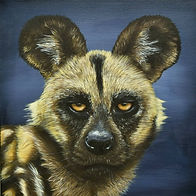
A.
African Wild Dog: an endangered species native to sub-Saharan Africa. They can have a home range of several hundred square miles, in which they are incredible hunters with an 80% success rate! Compare that to lions at around only 30%. Also known as the Painted dog, their markings are all unique.
Afflatus: a strong creative impulse, especially as a result of divine inspiration.
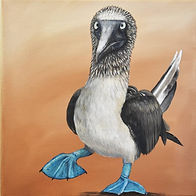
B.
Blue-footed Booby: with these guys it is all about the feet! The blue pigment is from their fish based diet and the bluer the better! Their name comes from the Spanish word 'bobo' which translates to foolish, and if you ever get the chance to see these guys waddle and stomp their way around, especially their mating dance, you'll understand.
Benignity: the quality or condition of being kind and gentle. A kindly or gracious act.
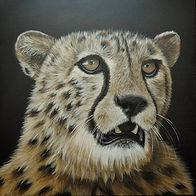
C.
Cheetah: Some things you may not know about the cheetah; they are the fastest land mammal on earth able to reach 100kph in three seconds! However, they're only able to sustain this for about a minute and limited to a couple hundred metres. During that time though their stride length can reach a whopping seven metres! Pretty impressive!
Candour: the quality of being open and honest; frankness.
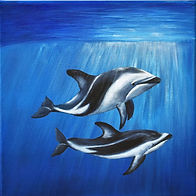
D.
Dusky Dolphin: These beautiful wee dolphins are found around coastal areas and continental shelves in the Southern Hemisphere. Fast, agile and always on the go, they are often termed the acrobats of the sea, mostly for the stunning aerial performances they can put on! Super social, they can be found in pods of up to 1000!
Deambulate: the act of walking abroad or about.

E.
Elephant: The largest animal to roam the land, these beautiful creatures are incredibly intelligent, compassionate and social. A couple of facts for you; they have the longest gestation of any mammal at 22 months, giving birth to a 120kg calf! Also, their trunks can suck up to 14 litres of water at a time, which is helpful considering they need about 160L a day! Not only large in stature!
Effulgent: Radiant, shining brilliantly. Showing or expressing vitality, love or joy.
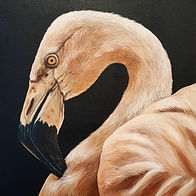
F.
Flamingo: These beautiful birds get their striking pink plumage from their diet, crustaceans and plankton high in carotenoids. There are six species and each has unique methods of feeding but all use that big beak as a shovel, plunging their heads in the water upside down and filtering the mud and silt from their food.
Felicific: Producing or tending to happiness.
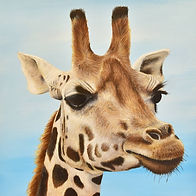
G.
Giraffe: Those horn-like structures on their head are called ossicones. Hardened cartilage covered in skin and fur which aid males, especially, when fighting. Giraffe also sleep standing up and only need about 30mins a day! I am certainly no giraffe. They are known to be very quiet. Sure, they grunt, snort and hiss occasionally but it wasn't until recently that it was discovered they make low-pitch noises such as hums which are below the range of humans ability to hear.
Garrulous: Excessively talkative, especially on trivial matters.
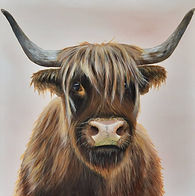
H.
Highland cow: These big gentle beasts originate from Scotland, most noticeably known for their luscious locks and stylish hair cut. This helps keep them warm up in the Scottish Highlands and flies (or bloody midges) out of their eyes. They are normally found in a range of colours from red and ginger to black. It's been said however, that Queen Victoria preferred the red coloured cattle and so in order to please her, the red ones were selectively bred with black ones declining over time.
Hirsute: Hairy, shaggy; untrimmed.

I.
Ibex: Otherwise known as a mountain goat, the Ibex is predominately found in the European Alps. Tough terrain but they've adapted to this environment by being able to jump 6ft from a standing start, and their hooves have sharp edges and concave undersides which act like suction cups on this mountainous terrain. Both males and females grow very long horns that curve backwards, with the males sometimes reaching 1.5m in length! That's a hefty load to carry on your noggin!
Irenic: Aiming or aimed at peace.
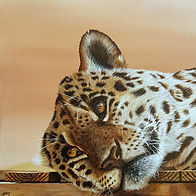
J.
Jaguar: The third largest of all big cat species, these powerful felines can be found in South America. Often confused with the leopard (found in Asia and Africa), jaguars have slightly different markings. Officially called rosettes, jaguars will have black dots in the center of some. Jaguars also have larger heads and shorter, stockier builds which is essential for them to hunt their large prey! Incredibly powerful in not only build but also bite- more powerful than any other big cat relative to size! Their jaws and teeth are able to bite through thick hides of crocodiles and turtle shells.
Jocund: Sprightly and lighthearted in disposition, character and quality.
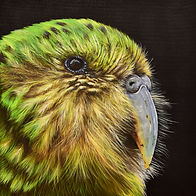
K.
Kakapo: The Kakapo is one of New Zealand's beloved flightless birds. It is a ground-dwelling, nocturnal parrot that, like most the country's birds, is critically endangered; there are only about 201 known adults all of who live on four predator free islands off NZ's coast. With so few Kakapo, each one has a name, and the most well known is Sirocco. If you don't know him, have a wee search on YouTube of "Kakapo Stephen Fry" and you'll get an insight into the character of these stunning birds.
Kalon: The ideal of physical and moral beauty especially as conceived by philosophers of classical Greece; Beauty is more than skin deep.
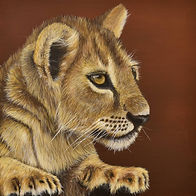
L.
Lion: Lion cubs are born blind and pretty helpless, away from the main pride. It takes a few weeks before mum will introduce them, once they're big enough to follow along. Cubs will nurse for about six months, after which they get the scraps of meat until they can start hunting for themselves. Eventually males will leave the pride but the females tend to stick around. With the threat from adult males and predators, the survival rate of cubs is rather shocking, but I guess that is all part of the circle of life!
Lissome: Moving or able to move with grace and ease; lithe and graceful.

M.
Meerkat: These wee cuties live in deserts and grasslands of southern Africa in mobs of up to 50. They forage for food during the day, and have designated jobs which rotate through the group. If there are newborn pups, several 'babysitters' will stay at the burrow to protect them from predators. Amongst the forages, one of them will stand guard, known as the sentry, finding a high vantage point and standing on their hind legs scanning the area. If they sense danger they will let out a high-pitched squeal, sending the mob scurrying for cover!
Mellifluous: having a pleasant or flowing sound; as if sweetened by honey.
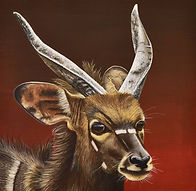
N.
Nyala: Spiral-horned antelope found in Southern Africa. There are stark differences between male and female; adult males weigh nearly twice that of females, and also grow those stunning double twisted horns for fighting. The other difference is colour. When born, both have reddish coats with vertical white stripes, however, as the male grows, this changes to coarse, dark gray fur with pale stripes across the back. Despite those big eyes, their eyesight is generally poor, instead relying on their big ears to listen out for predators.
Nonpareil: a person or thing that is unsurpassed and unmatched; a peerless example.
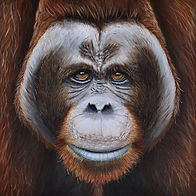
O.
Orangutan: They are the only great ape to spend most of their lives in the trees- also the heaviest arboreal mammal in the world! We share 97% DNA, and their name comes from Malay words "orang hutan", translating to "human of the forest". The thing I find the most endearing, and a nod to the naming of the painting, is that young will stay with their mother for up to eight years, normally semi-solitary. During this time they form one of the strongest bonds in nature as she teaches her offspring how to survive.
Opsimath: one who learns late in life.
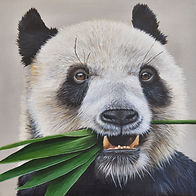
P.
Panda: Found in thick bamboo forests of central China, pandas can spend up to 16 hours a day chewing through bamboo shoots just to gain enough sustenance for survival! Sadly though, half of new-borns die from disease or being accidentally crushed by their 200lb mothers. Giant pandas are fighting to survive as deforestation and poaching decreases their natural habitat and population. However, a few years ago the giant panda was updated from 'Endangered' to 'Vulnerable' on a red list of threatened species, going to show that it is possible to save our wildlife!
Pabulum: a substance that gives nourishment; food. Intellectual nourishment.
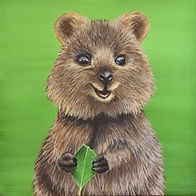
Q.
Quokka: A small marsupial mostly found on Australia's Rottnest Island, is often termed 'the happiest animal on Earth'. Their adorable wee toothy grins and chubby, round cheeks have made them a bit of star. However, a not so happy rumour surrounding these critters is that they throw their young at predators in order to escape. This is not 100% true. Being a marsupial, the young are carried in a pouch, and if mum is being pursued by a predator she will sacrifice her baby by relaxing her pouch muscles, causing the joey to drop out. So not technically a throw, but still a bit ruthless. Nature huh.
Quiddity: the essential nature or quality of something that makes it different.
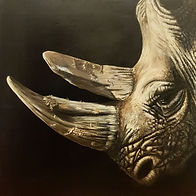
R.
Rhinoceros: A group of rhino is called a 'crash' and each can run at speeds of up to 50kph. You can just imagine the carnage they would cause should they crash your party! But rhino are actually pretty docile, with generally bad eyesight making them quite the sitting target. Rhino are being poached to near extinction, mostly after their horns. Unlike other horned mammals, rhino horn consists mostly of keratin which is similar to human hair and nails. This slowly grows back so strategies such as 'de-horning' are one way in which conservationists are helping them.
Riant: Smiling; cheerful.
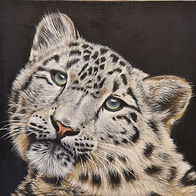
S.
Snow Leopard: These elusive creatures are native to mountain ranges of Central and South Asia, the highest-living land predators. Sometimes known as 'ghosts of the mountains' because they inhabit such vast, remote spots and have brilliant camouflage making them difficult to track.
Adaptations include wide nasal cavities helping to heat air before it reaches their lungs, a short, stocky body with incredibly thick fur to maintain heat, plus an unmistakably large, fluffy tail which they use like a scarf to keep them warm!
Serein: Fine tropical rain falling from cloudless night sky.

T.
Tiger: Tigers are the largest amongst the big cats, with most of the remaining wild population found in India (about 3000). They are one of the stealthiest hunters, not only thanks to their stripy camouflage, but they also have soft toe pads that enable them to stalk quietly through their habitat. Hunting mostly at night, one substantial feed, such as a deer, can sustain them for a whole week!
Tutelar: Being or serving as a guardian or protector.
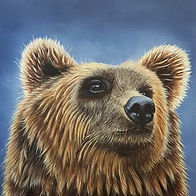
U.
Ursus arctos (Brown bear): Second biggest of the eight bear species after the polar bear, they are adorably cuddly and reminiscent of your childhood bestie. Found across Europe and North America, there are two types of brown bear recognized; the coastal brown and the grizzly. The latter getting their name due to longer hair on the back and shoulders with a cream tinge. As big and bulky as they may seem, you're probably not going to outrun a grumpy grizzly, unless you can sprint 50km/h.
Undern: The time from noon to sundown; a light meal in the forenoon.

V.
Vulpes vulpes (Red fox): The largest of the true foxes and widely distributed across the Northern Hemisphere, more than 40 subspecies exist, each highly adapted for a variety of different habitats.
They have a reputation for being smart, cunning and sly opportunists, skulking through the woods in search of food before disappearing into the thick bush before you get a chance to say 'fox!'.
Vafrous: Crafty, cunning, sly.
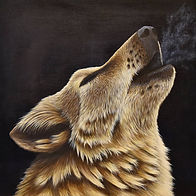
W.
Wolf: Wolves are a highly social creature, forming tight packs led by alpha male and females, who mostly mate for life. They have a complex communication system involving body language, barking, growling and, most noticeably, howling. While we think they just howl at the moon, this unique form of communication alerts to dangers, territorial positions and for mating purposes. Just like our voices, each wolf also has a distinctive howl.
Welkin: The sky or heaven; upper atmosphere.
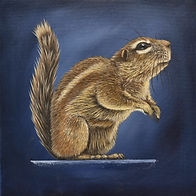
X.
Xerus: A small mammal commonly known as an African ground squirrel, they are native to Africa and make their homes in burrows across the desert, grasslands and savannas. A social animal, males and females usually live in separate groups; males in groups up to 20 while females live with only a handful of others and their pups. Their fluffy tail is an essential tool for survival in the hot savanna as they use it like an umbrella to shelter from that unbearable heat!
Xeric: Of, characterised by, or adapted to an extremely dry habitat.
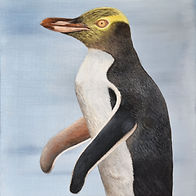
Y.
Yellow-eyed Penguin: One of the rarer penguins, these endangered little fellows are only found in New Zealand. They build nest sites in native coastal forests, scrub or dense flax, visually isolated from others and protected from the sometimes harsh conditions of Southern NZ. They can be an incredibly shy penguin, though there are known locations where you may be lucky enough to see them waddle up and down the beach. If you fail to see them in real life though, never fear, because this beautiful bird graces our $5 note; a very worthy place for such a special wee penguin!
Yare: Agile, lively, nimble; Responding easily, maneuverable
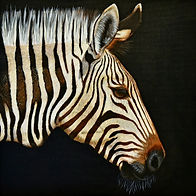
Z.
Zebra: These beautiful creatures are well known for their mesmerising stripes. While you think this colour combo would stand out on the African plains, when grouped together it confuses their colourblind predators and camouflages like grass. Another tactic to avoid being caught is running away in a zigzag pattern, but if they do get caught, their incredibly powerful kick can be enough to kill a fully grown lion!
Zoetic: of or relating to life; living, vital.